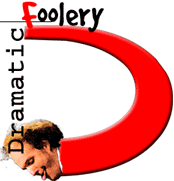CLOWNARCHY RULES!
Drew Richardson used to be your everyday clown, performing the kind of shtick everyone does who studies clowning in theater school. But over the years his work has become smarter and more insightful, with the kind of honest emotional undercurrent that comes only when a performer is comfortable opening up onstage. Richardson has perfected the baby-faced naif, the sweet, blue-eyed innocent who finds himself thrown into a world of stubborn appliances and hostile laws of physics. Even when his premise is intellectual--as it is in "The Psychology of Clumsiness," exploring current theories of how the brain functions--it's his ability to alternately emulate an overintellectualizing adult and an enchanted preschooler that makes the work hilarious. Especially killing is Richardson's illustration of the difference between left- and right-brain thinking, as he tells a story, rebus-style, using such props as old magazines, Barbie dolls, and rubber chickens. If you don't leave knowing a little more about the human brain than you did before, you were probably laughing too hard. Richardson performs as part of "Clownarchy Rules!," a two-weekend festival curated by George Fuller that showcases some of Chicago's most accomplished and eccentric clowns.—Jack Helbig
CRITIC'S CHOICE
THE PSYCHOLOGY OF CLUMSINESS
The first time I saw trained clown Drew Richardson perform, in 1989, I hated him. I hated his show, an ambitious but flawed attempt to explore the two sides of clowning, the mischievous trickster and the playful child. I hated that he called himself a "dramatic fool" because to my eyes he seemed only a glorified mime. But most of all I hated the fact that, for all his clownish posturing, he wasn't funny. So I panned him. And Richardson, a good artist, kept on doing what he was doing and taking every chance he could get to explore his art--in this case physical comedy in the tradition of Buster Keaton, Jacques Lecoq, and Laurel and Hardy. And over the years his work deepened, his range of comic styles broadened, and he developed a delightful stage persona, a sweet naif constantly at war with mean-spirited inanimate objects. His current show is a series of sketches--some silent, some not--in which he explores the ins and outs of the human brain. In one hilarious bit, Richardson illustrates the difference between left- and right-brain thinking by telling a story in which props--magazines, Barbie dolls, rubber chickens--represent words. Not all the bits are so clearly related to the theme, however: I still cannot for the life of me figure out what a sketch about plugging in a stereo with a frustratingly short cord was doing in this show. But frankly I was laughing too hard to care. Neo-Futurarium, 5153 N. Ashland, 773-279-8551. Through November 19: Wednesdays, 8 PM. $8. —Jack Helbig

